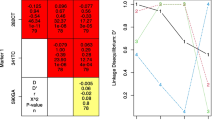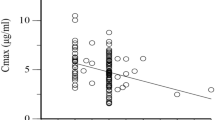Abstract
The pathogenesis of hypersensitivity to trimethoprim‐sulfamethoxazole (TMP‐SMX) is supposed to be associated with the slow acetylation phenotype. This pharmacogenetic defect is associated with the mutations of the arylamine N‐acetyltransferase (NAT2) encoding gene. The aim of the study was to compare the usefulness of the acetylation phenotype and NAT2 coding genotype in the prediction of idiosyncratic reaction to Cotrimoxazole in infants. The study was carried out in the group of 20 infants, aged 2‐12 months (mean age 6.3 months) treated with Cotrimoxazole, administered at 100 mg/kg b.w./24 h doses. In seven children (35%) no adverse effects of the treatment have been observed, whereas in 13 (65%) children various adverse effects occurred as a result of the therapy, such as rash (4 children), granulocytopenia with anemization (5 children) or liver impairment (4 children). The acetylation phenotype of each child was determined on the basis of urine of N‐acetyl isoniazid/isoniazid ratio, after ingestion of isoniazid as a model drug. Furthermore we used polymerase chain reaction (PCR) followed by the analysis of restriction fragments length polymorphism (RFLP) technique to identify the known mutant alleles of the NAT2 gene. It has been presumed that the genotype determining fast acetylation contains at least one of wild‐type allele. No correlation has been found between the observed adverse effects of Cotrimoxazole and age, gender and acetylation phenotype. However, it has been demonstrated that the risk of adverse effects of Cotrimoxazole is considerably higher in children with mutations of the NAT2 encoding gene. The comparison of the results from PCR‐RFLP genotyping with phenotyping suggested that in infants, the NAT2 genotype rather than phenotype provides the basis for the detection of hypersensitivity to TMP‐SMX.
Similar content being viewed by others
References
Davey RTJ, Masur H. Recent advances in the diagnosis, treatment and prevention of Pneumocystis carini pneumonia. Antimicrob Agents Chemother 1990;34:499–504.
Goodwin SD. Pneumocystis carini pneumonia in human immunodeficiency virus-infected infants and children. Pharmacotherapy 1993;13:640–6.
Curtis BR, McFarland JG, Wu GG, Visentin GP, Aster RH. Antibodies in sulfonamide-induced immune thrombocytopenia recognize calcium dependent epitopes on the glycoprotein IIb/IIIa complex. Blood,1994;84:176–83.
Gupta A, Eggo MC, Uetrecht JP, Cribb AE, Daneman D, Rieder MJ, Shear NH, Cannon M, Spielberg SP. Drug-induced hypothyroidism: the thyroid as a target organ in hypersensitivity reactions to anticonvulsants and sulfonamides. Clin Pharmacol Ther 1992;51:56–67.
Meekins CV, Sullivan TJ, Gruchalla RS. Immunochemical analysis of sulfonamide drug allergy: identification of sulfamethoxazole-substituted human serum proteins. J Allergy Clin Immunol 1994;6:1017–24.
Murphy JL. Renal tubular acidosis in children treated with Trimethoprim-Sulfamethoxazole during therapy for acute lymphoid leukemia. Pediatrics 1992;89:1072–4.
Rieder MJ, Sisson E, Bird IA, Almawi WY. Suppression of Tlymphocyte proliferation by sulphonamide hydroxylamines. Int J Immunopharmac 1992; 14:1175–80.
Uetrecht JP, Shear NH, Zahid N. N-chlorination of sulfamethoxazole and dapsone by the myeloperoxidase system.Drug Metab Dispos 1993;21:830–834.
Carr A, Tindall B, Penny R, Cooper DA. In vitro cytotoxicity as a marker of hypersensitivity to sulphamethoxazole in patients with HIV. Clin Exp Immunol 1993;94:21–5.
Cribb AE, Spielberg SP Sulfamethoxazole is metabolized to the hydroxylamine in humans. Clin Pharmacol Ther 1992;51:522–6.
Lee BL, Delahunty T, Sqafrin S. The hydroxylamine of sulfamethoxazole and adverse reactions in patients with acquired immunodeficiency syndrome. Clin Pharmacol Ther 1994;56: 184–9.
Van der Ven AJAM, Mantel MA, Vree TB, Koopmans PP, van der Meer JW. Formation and elimination of sulphamethoxazole hydroxylamine after oral administration of sulphamethoxazole. Br J Clin Pharmacol 1994;38:147–50.
Van der Ven AJAM, Vree TB, Koopmans PP, van der Meer JWMN. Metabolites and side effects of trimethoprim-sulfonamide combinations. Chemotherapie J 1997;6:28–30.
Vree TB, van der Ven AJAM, Koopmans PP, van Ewijk-Benken Kolmer EWJ, Verwey-van Wissen CPWGM. Pharmacokinetics of sulfamethoxazole with its hydroxy metabolites and N4-acetyl-, N1-glucuronide conjugates in healthy human volunteers. Clin Drug Invest 1995;9:43–53.
Cribb AE, Nakamura H, Grant DM, Miller MA, Spielberg SP. Role of polymorphic and monomorphic human arylamine Nacetyltransferase in determining sulfamethoxazole metabolism. Biochemical Pharmacology 1993;45:1277–82.
Nakamura H, Uetrecht J, Cribb AE, Miller MA, Zahid N, Hill J, Josephy PD, Grant DM, Spielberg SP. In vitro formation, disposition and toxicity of N-acetoxy-sulfamethoxazole, a potential mediator of sulfamethoxazole toxicity. J Pharmacol Exp Ther 1995;274:1099–104.
Rieder MJ, Shear NH, Kanee A, Tang BK, Spielberg SP. Prominence of slow acetylator phenotype among patients with sulfonamide hypersensitivity reactions. Clin Pharmacol Ther 1991;49:13–7.
Carr A, Gross AS, Hoskins JM, Penny R, Cooper DA. Acetylation phenotype and cutaneous hypersensitivity to trimethoprim-sulphamethoxazole in HIV-infected patients. AIDS 1994;8:333–7.
AgÚndez JAG, Martínez C, Olivera M, Ledesma MC, Ladero JM, Benítez J. Molecular analysis of the arylamine N-acetyltransferase polymorphism in a Spanish population. Clin Pharmacol Ther 1994; 56:202–9
Cascorbi I, Drakoulis N, Brockmöller J, Maurer A, Sperling K, Roots I. Arylamine N-acetyltransferase (NAT2) mutations and their allelic linkage in unrelated Caucasian individuals: correlation with phenotypic activity. Am J Hum Genet 1995;57: 581–92.
Deguchi T. Sequences and expression of alleles of polymorphic arylamine N-acetyltransferase of human liver. J Biol Chem 1992; 267: 18140–47.
Hickman D, Risch A, Buckle V, Spurr NK, Jeremiach SJ, McCarthy A, Sim E. Chromosomal localization of human genes for arylamine N-acetyltransferase. Biochem J 1994; 297: 441–5.
Bell DA, Taylor AJ, Butler MA, Stephens EA, Wiest J, Brubaker LH, Kadlubar FF, Lucier GW. Genotype/phenotype discordance for human arylamine N-acetyltransferase (NAT2) reveals a new slow-acetylator allele common in African-Americans. Carcinogensis 1993;14:1689–92.
Blum M, Demierre A, Grant DM, Heim M, Meyer UA. Molecular mechanism of slow acetylation of drugs and carcinogenes in humans. Proc Natl Acad Sci USA 1991;88:5237–41.
Ferguson RJ, Doll MA, Rustan TD, Gray K, Hein DW. Cloning expression and functional characterization of two mutant (NAT2191 and NAT2341/803 ) and wild-type human polymorphic N-acetyltransferase (NAT2) alleles. Drug Metab Disp 1994;22:371–6.
Hickman D, Sim E. N-acetyltransferase polymorphism. Comparison of phenotype and genotype in humans. Biochem Pharmacol 1991;42:1007–14.
Hickman D, Risch A, Camilleri J, Sim E. Genotyping human polymorphic arylamine N-acetyltransferase: identification of new slow allotypic variants. Pharmacogenetics 1992;2:217–26.
Grant DM. Molecular genetics of the N-acetyltransferase. Pharmacogenetics 1993;3:45–50.
Vesell ES. The model drug approach in clinical pharmacology. Clin Pharmacol Ther 1991;50:239–48.
Skrętkowicz J, Zasada M, Polakowski P. Porównanie dwóch najczęściej stosowanych metod oznaczania fenotypu acetylacji. Farmacja Polska 1990; 46:149–51.
Vatsis KP, Weber WW, Bell DA, Dupert JM, Evans DAP, Grant DM, Hein DW, et al. Nomenclature for N-acetyltransferases. Pharmaogenetics 1995;5:1–17.
Rane A. The major physiological factors that modulate drug metabolism in man. Implications for drug effects and toxicity. In: Pacifici GM, Fracchia GN, eds. Advances in drug metabolism in man. Brussels, Luxembourg: ECSC-EC-EAEC, 1995.
Mashomo M, Suzuki T, Abe M, Deguchi T. Molecular genotyping of N-acetyltransferase polymorphism to predict phenotype. Hum Genet 1992; 90:139–43.
Pariente-Khayat A, Pons G, Rey E, Richard MO, D'athis Ph, Moran C, Badoual J, Olive G. Caffeine acetylator phenotyping during maturation in infants. Pediatric Reseach 1991;29:492–5.
Zielińska E, Niewiarowski W, Bodalski J, Rębowski G, Skrętkowicz J, Polakowski P. Relation between genotype for human arylamine N-acetyltransferase (NAT2) and phenotype acetylation in children under 2 years old. Thérapie 1995;suppl:84 (abstract).
Zielińska E, Niewiarowski W, Bodalski J, Rębowski G, Matusiak I. Molecular genotyping of the arylamine N-acetyltransferase polymorphism in children. Medical Science Monitor 1997; in press.
Mrozikiewicz PM, Cascorbi I, Brockmöller J, Roots I. Determination and allelic allocation of seven nucleotide transitions within the arylamine N-acetyltransferase gene in the Polish population. Clin Pharmacol Ther 1996; 59: 376–82.
Blaser J, Joos B, Opravil M, Lüthy R. Variability of serum concentration of Trimethoprim and Sulfamethoxazole during high dose therapy. Infection 1993;21:206–9.
Author information
Authors and Affiliations
Rights and permissions
About this article
Cite this article
Zielińska, E., Bodalski, J., Mianowska, K. et al. Genotyping of the arylamine N‐acetyltransferase polymorphism in the prediction of idiosyncratic reactions to trimethoprim‐sulfamethoxazole in infants.. Pharm World Sci 20, 123–130 (1998). https://doi.org/10.1023/A:1008664707825
Issue Date:
DOI: https://doi.org/10.1023/A:1008664707825




